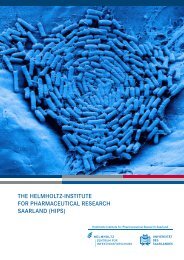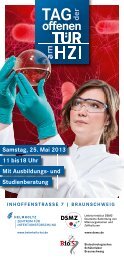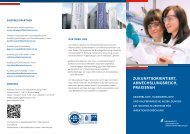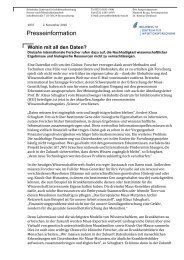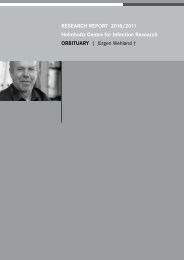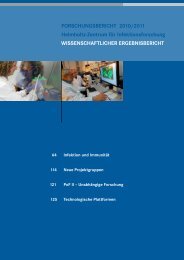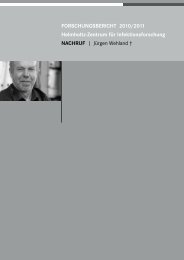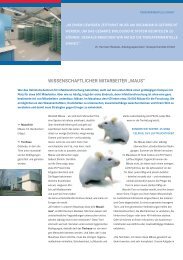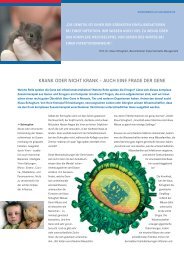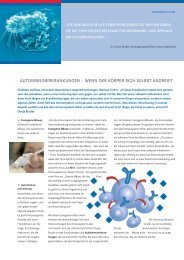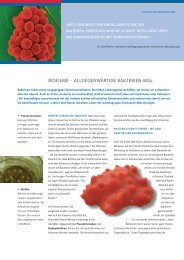Research Report 2010 2011 - Helmholtz-Zentrum für ...
Research Report 2010 2011 - Helmholtz-Zentrum für ...
Research Report 2010 2011 - Helmholtz-Zentrum für ...
Create successful ePaper yourself
Turn your PDF publications into a flip-book with our unique Google optimized e-Paper software.
106 SCIENTIFIC REPORTS | Infection and Immunity | Strategies for Prevention and Therapy<br />
04.5 Therapeutic Cellular Vaccines<br />
PROJECT LEADER | Dr. Werner Lindenmaier | Department of Gene Regulation and Differentiation |<br />
wli@helmholtz-hzi.de<br />
PROJECT MEMBERS | Dr. Kurt E. J. Dittmar | Dr. Wilhelm Meyring | Dr. Oliver Schön | Dr. Nadia Zghoul |<br />
Claudia Preuß | Ellen Kuppe<br />
Cell-based immunotherapies have great potential for the<br />
treatment of tumours and persistent infections. Activation<br />
of the cellular immune response can eliminate the cancer<br />
cells and the cells which are persistently infected. However,<br />
tumour cells and persistent pathogens have evolved mechanisms<br />
to escape the normal immune response. Therefore,<br />
specific stimulation by professional antigen presenting cells,<br />
especially dendritic cells (DC), is necessary to overcome<br />
these obstacles. On the other hand, a strong induction of<br />
the immune response, especially when directed against self<br />
tumour antigens, bears the danger of inducing pathogenic<br />
autoimmunity. In this case control of the overwhelming<br />
response by immunesuppressive cells like mesenchymal<br />
stromal cells is an attractive option.<br />
Sterile docking for cellular therapies However, the biggest<br />
obstacle for broader application of cellular therapies is the<br />
requirement of autologous primary cells which have to<br />
be prepared under cGMP conditions in accordance to EU<br />
legislation.<br />
As a tool to overcome this hurdle we have developed completely<br />
closed bag systems for cGMP compliant dendritic cell<br />
generations. Using sterile docking, all steps starting from cell<br />
isolation up to the final formulation and cryo-conservation<br />
of adenovirally modified DC can be realized without opening<br />
the system. In addition to the development of the cultivation<br />
system we investigated whether the stimulatory capacity of<br />
the DC vaccine is enhanced by infection with M. bovis BCG<br />
using flow cytometry, expression profiling and confocal and<br />
electron microscopy and how the balance between anti-tumour<br />
immunity and autoimmunity after DC vaccination can<br />
be controlled in a transgenic murine model system.<br />
So far, the bag system only allowed the cultivation of suspension<br />
cells. Adherently growing cells like mesenchymal stem<br />
cells require adherence-compatible modified surfaces. This<br />
modification can be achieved using dielectric barrier discharge<br />
(plasma). Plasma treatment in the presence of suitable<br />
precursors such as silanes or amino-functionalized compounds<br />
allows selective modification of surface properties.<br />
We have identified suitable surface coatings, which support<br />
adherence and survival of MSC whereas cells in unmodified<br />
bags aggregated and eventually died.<br />
Modified bag MSC in comparison to conventional flask<br />
MSC MSC grown on modified bag surfaces were extensively<br />
analysed in comparison to conventional flask MSC. Analysis<br />
of cell specific surface markers, gene transfer efficiency,<br />
adipogenic and osteogenic differentiation and global expression<br />
profiles did not reveal significant differences between<br />
bag- and flask-MSC. Bag modification using dielectric barrier<br />
discharge therefore opens up new possibilities for the cultivation<br />
of therapeutic cells in a closed system.<br />
Furthermore, secondary surface modification (e.g. by<br />
coupling of cell-specific antibodies) has been used to isolate<br />
CD14 + monocytes from peripheral blood. Leukocytes and<br />
structured modification of the surface allowed localized<br />
adherence and genetic modification providing a tool for the<br />
analysis of interactions between different cell types.<br />
Garritsen,H.S., Macke,L., Meyring,W., Hannig,H., Pägelow,U., Wörmann,B., Geffers,R.,<br />
Dittmar,K.E., and Lindenmaier,W. (<strong>2010</strong>). Efficient generation of clinical-grade genetically<br />
modified dendritic cells for presentation of multiple tumor-associated proteins.<br />
Transfusion. 50, 831-842.<br />
Adherent growth on modified surface and karyotype stability<br />
of MSC A) Electron micrograph of MSC growing adherently on<br />
modified bag surface (Coop.: M. Rohde, HZI).<br />
B) Even after passage 22 a normal diploid karyotype is<br />
maintained. (Coop.: K. Miller, MHH).<br />
Macke,L., Garritsen,H.S., Meyring,W., Hannig,H., Pagelow,U., Wörmann,B.,<br />
Piechaczek,C., Geffers,R., Rohde,M., Lindenmaier,W., and Dittmar,K.E. (<strong>2010</strong>). Evaluating<br />
maturation and genetic modification of human dendritic cells in a new polyolefin<br />
cell culture bag system. Transfusion. 50, 843-855.<br />
Dittmar,K.E.J., Simann,M., Zghoul,N., Schön,O., Meyring,W., Hannig,H., Macke,L.,<br />
Dirks,W., Miller,K., Garritsen,H.S.P., and Lindenmaier,W. (<strong>2010</strong>). Quality of Cell<br />
Products: Authenticity, Identity, Genomic Stability and Status of Differentiation. Transfusion<br />
Medicine and Hemotherapy 37, 57-64.



